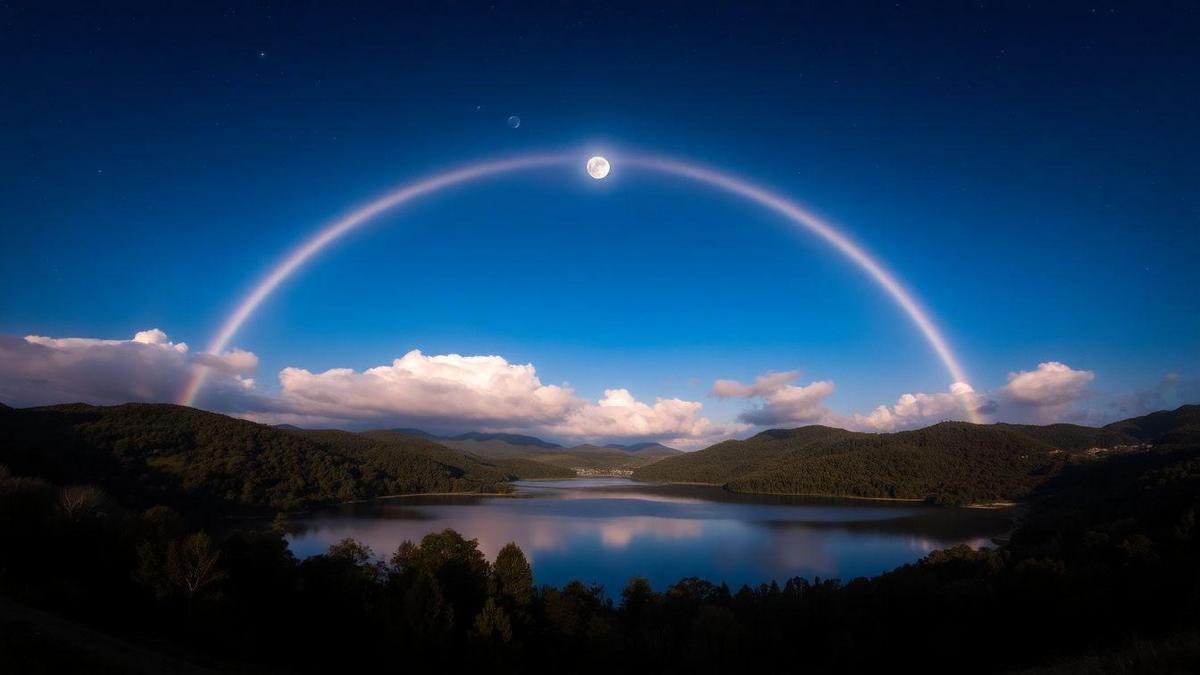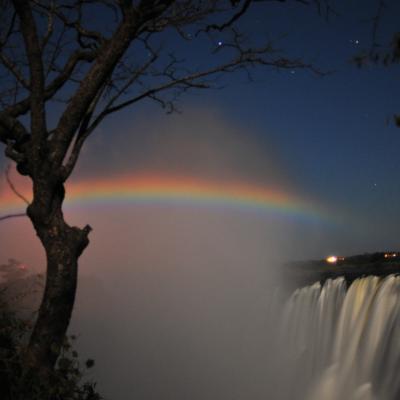Anúncios
These events are the result of the complex interaction between light and atmospheric particles. Observing such phenomena is to experience a natural spectacle of science and poetry.
By understanding how these phenomena occur, we expand our view of nature. Atmospheric optics not only captivates but also reveals important clues about the climate and environment. Thus, science and contemplation come together harmoniously.
Anúncios

What Are Lunar Rainbows?
Lunar rainbows, or moonbows, are nighttime versions of solar rainbows. They form when moonlight passes through water droplets suspended in the air. This process of refraction and reflection creates a pale arc in the night sky.
For a lunar rainbow to occur, the moon must be nearly full. Additionally, the sky must be clear and dark, and there must be moisture in the air. This combination makes the phenomenon rare and special to observe.
Unlike daytime rainbows, lunar ones have very soft colors. They often appear white or silvery, with a faint brightness. This happens due to the low intensity of moonlight compared to sunlight.
Despite being subtle, these arcs enchant attentive observers. The delicate beauty of the moonbow invites quiet contemplation. They are visual memories marked by the serenity of the moment.
The Science Behind Optical Phenomena
Optical phenomena such as arcs, halos, and glories follow well-defined physical principles. Light interacting with water or ice crystals results in refraction, reflection, and diffraction. The atmosphere acts as a gigantic natural laboratory.
In the case of lunar rainbows, moonlight passes through water droplets. It bends when entering and exiting the droplet, splitting into colors. This phenomenon is refraction, followed by internal reflection in the droplet.
Halos are caused by ice crystals at high altitudes. Light refracts when passing through these crystals, forming circles around the moon. The specific angle of 22 degrees is a common feature.
Glories and coronas, on the other hand, occur through diffraction, involving much smaller particles. They form colorful rings around shadows or light sources. Each shape reveals different interactions between light and the atmosphere.
Other Rare Optical Phenomena in the Atmosphere
Besides lunar rainbows, there are a number of intriguing phenomena in the sky. Halos, glories, and coronas are remarkable and dazzling examples. They illustrate how small particles affect light in fascinating ways.
Halos usually appear as rings around the sun or moon. They are formed by the refraction of light through suspended ice crystals. They are common in cold regions or at high altitudes.
Glories are more difficult to observe and have a more delicate appearance. They arise when the observer’s shadow is projected onto clouds. A set of colorful rings appears around that shadow.
Coronas, in turn, occur through the diffraction of light in water droplets. They form smooth circular patterns around luminous sources. Their ethereal appearance complements the set of celestial beauties.
How Do Lunar Rainbows and Rare Optical Phenomena Occur?
Lunar rainbows, also known as moonbows, are a fascinating natural phenomenon that occurs when moonlight is refracted, reflected, and dispersed through water droplets in the atmosphere. This results in an arc similar to a rainbow that can be seen in the night sky. Unlike traditional rainbows, which are created by sunlight, lunar rainbows form under specific conditions that are relatively rare. The moon must be nearly full, and the sky must be dark and clear, allowing optimal visibility of moonlight. The presence of rain or other moisture in the air is crucial, as it provides the necessary water droplets for interaction with light.
The science behind lunar rainbows is rooted in the principles of optics. When moonlight passes through water droplets, it undergoes a process called refraction, where the light bends as it enters and exits the droplet. This bending of light causes it to separate into its constituent colors, creating a spectrum that can be seen as a faint arc in the sky. The intensity of the moonbow is often much weaker than that of a daytime rainbow due to the lower brightness of moonlight compared to sunlight. Additionally, the colors of a lunar rainbow are typically less vibrant, appearing more white or pale.
Other rare optical phenomena can occur in the atmosphere, such as halos, glories, and coronas. Halos are circular arcs that appear around the sun or moon, formed by the refraction of light through ice crystals in the atmosphere. Glories are small colorful rings that can be seen around the shadow of an observer’s head, typically when viewed from a high point above clouds. Coronas are similar to glories but are produced by diffraction of light around water droplets instead of ice crystals. Each of these phenomena is a testament to the intricate interaction between light and atmospheric conditions, creating stunning displays that capture the imagination.
Understanding how lunar rainbows and other rare optical phenomena occur not only deepens our appreciation for the natural world but also enriches our knowledge of atmospheric science. By studying these events, scientists can gain insights into the processes that govern weather patterns, climate change, and the behavior of light under various conditions. Moreover, the study of these phenomena can inspire future generations to explore the fields of physics and environmental science, fostering a sense of wonder and curiosity about the universe.
Advantages of Understanding Lunar Rainbows and Rare Optical Phenomena in the Atmosphere

Understanding lunar rainbows and rare optical phenomena in the atmosphere offers several advantages, both from a scientific and cultural perspective. Firstly, from a scientific standpoint, studying these phenomena enhances our understanding of atmospheric conditions and light behavior. This knowledge can lead to advances in meteorology and climatology, as researchers can better predict weather patterns and understand the impact of climate change on atmospheric optics. By understanding how light interacts with different particles in the atmosphere, scientists can develop more accurate models to forecast weather events, which can ultimately save lives and property.
Secondly, lunar rainbows and other optical phenomena can serve as a gateway to engaging the public in science. When individuals witness these impressive displays in the night sky, it often sparks curiosity and encourages them to learn more about the science behind the phenomenon. This engagement can lead to increased interest in astronomy, physics, and environmental science, inspiring future scientists and researchers. Educational programs that focus on these phenomena can help cultivate a generation that values scientific inquiry and exploration.
Furthermore, understanding these phenomena can enhance our appreciation of the natural world. Lunar rainbows and other optical occurrences remind us of the beauty and complexity of our environment. They encourage individuals to pause and reflect on the wonders of nature, fostering a sense of connection with the Earth and the cosmos. This appreciation can lead to a greater commitment to environmental conservation and sustainability, as people become more aware of the delicate balance that exists in our atmosphere.
Lastly, the cultural significance of lunar rainbows and rare optical phenomena should not be overlooked. Throughout history, various cultures have attributed different meanings and symbolism to these phenomena, often seeing them as omens or messages from the divine. By understanding the cultural context of these events, we can gain insights into human history and the ways in which societies have interpreted and responded to natural occurrences. This cultural perspective enriches our understanding of lunar rainbows and optical phenomena, deepening our collective human experience.
How to Observe Lunar Rainbows and Rare Optical Phenomena in the Atmosphere

To successfully observe lunar rainbows and rare optical phenomena in the atmosphere, there are several key steps to follow.
Choose the Right Time and Place: The first step to observing a lunar rainbow is to select an appropriate time and location. Moonbows are most visible during the full moon, so checking the lunar calendar is essential. Also, find a location with a clear view of the sky, away from city lights and pollution, to maximize visibility.
Look for Rain and Moonlight: For a lunar rainbow to form, both rain and moonlight must be present. After a nighttime rain, when the moon is bright, is the ideal time to look for a moonbow. Keep an eye on the weather forecast and be ready to go out when conditions are right.
Use a Camera to Capture Images: Capturing the beauty of a lunar rainbow can be challenging, but using a camera with manual settings can help. A tripod is essential to stabilize the camera during long exposures, as moonlight is not as bright as sunlight. Experiment with different settings to find the best way to capture the moonbow’s ethereal glow.
Understand the Science Behind Moonbows: Familiarizing yourself with the science of moonbows can enhance your observing experience. Knowing how light refracts and reflects through water droplets can deepen your appreciation for the phenomenon as you witness it in real time.
Share Your Experience with Others: Observing a lunar rainbow can be a memorable experience, and sharing it with friends and family can increase the enjoyment. Discussing the phenomenon with others can also spark interest in science and nature, encouraging more people to appreciate the beauty of the night sky.
Appreciate the Beauty of Night Light: Finally, take a moment to simply enjoy the beauty of the night sky. Lunar rainbows are a reminder of nature’s wonders, and appreciating these moments can foster a sense of peace and connection with the universe.
By following these steps, you can increase your chances of witnessing the magical occurrence of lunar rainbows and other rare optical phenomena in the atmosphere. The experience can be both scientifically enlightening and personally enriching, leaving you with lasting memories of the beauty of the night sky.
Did You Enjoy Learning About Lunar Rainbows and Rare Optical Phenomena in the Atmosphere?
Lunar rainbows and rare optical phenomena in the atmosphere offer a unique glimpse into the wonders of nature and the science behind them. These dazzling displays not only capture our imagination but also encourage us to explore the complexities of light and the atmosphere.
As you continue your journey of discovery, consider seeking opportunities to observe these phenomena for yourself. The beauty of a moonbow can inspire
a deeper appreciation for the world around us and ignite a passion for scientific exploration.
Frequently Asked Questions
What is a lunar rainbow?
A lunar rainbow is a rainbow formed at night. It happens when moonlight passes through water in the air.
When can I see a lunar rainbow?
You can see a lunar rainbow on clear nights. The moon must be full, and the sky must be dark.
Are lunar rainbows rare?
Yes, they are quite rare! They appear a few times a year. Many people never see one.
What color is a lunar rainbow?
The colors are softer. You’ll see silver and blue tones, instead of red or green.
Are there other rare optical phenomena in the atmosphere?
Yes, besides lunar rainbows, there are halos and rings of light. They are also beautiful and interesting to observe.
